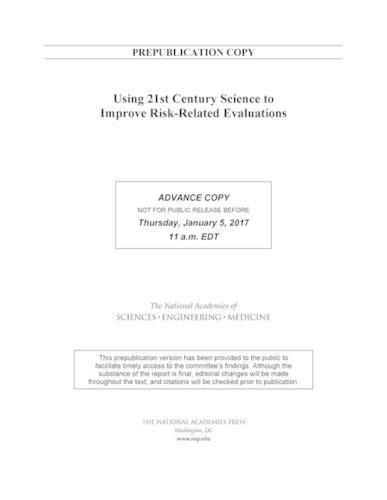Readings Newsletter
Become a Readings Member to make your shopping experience even easier.
Sign in or sign up for free!
You’re not far away from qualifying for FREE standard shipping within Australia
You’ve qualified for FREE standard shipping within Australia
The cart is loading…






Over the last decade, several large-scale United States and international programs have been initiated to incorporate advances in molecular and cellular biology, -omics technologies, analytical methods, bioinformatics, and computational tools and methods into the field of toxicology. Similar efforts are being pursued in the field of exposure science with the goals of obtaining more accurate and complete exposure data on individuals and populations for thousands of chemicals over the lifespan; predicting exposures from use data and chemical-property information; and translating exposures between test systems and humans.
Using 21st Century Science to Improve Risk-Related Evaluations makes recommendations for integrating new scientific approaches into risk-based evaluations. This study considers the scientific advances that have occurred following the publication of the NRC reports Toxicity Testing in the 21st Century: A Vision and a Strategy and Exposure Science in the 21st Century: A Vision and a Strategy. Given the various ongoing lines of investigation and new data streams that have emerged, this publication proposes how best to integrate and use the emerging results in evaluating chemical risk. Using 21st Century Science to Improve Risk-Related Evaluations considers whether a new paradigm is needed for data validation, how to integrate the divergent data streams, how uncertainty might need to be characterized, and how best to communicate the new approaches so that they are understandable to various stakeholders.
$9.00 standard shipping within Australia
FREE standard shipping within Australia for orders over $100.00
Express & International shipping calculated at checkout
Stock availability can be subject to change without notice. We recommend calling the shop or contacting our online team to check availability of low stock items. Please see our Shopping Online page for more details.
Over the last decade, several large-scale United States and international programs have been initiated to incorporate advances in molecular and cellular biology, -omics technologies, analytical methods, bioinformatics, and computational tools and methods into the field of toxicology. Similar efforts are being pursued in the field of exposure science with the goals of obtaining more accurate and complete exposure data on individuals and populations for thousands of chemicals over the lifespan; predicting exposures from use data and chemical-property information; and translating exposures between test systems and humans.
Using 21st Century Science to Improve Risk-Related Evaluations makes recommendations for integrating new scientific approaches into risk-based evaluations. This study considers the scientific advances that have occurred following the publication of the NRC reports Toxicity Testing in the 21st Century: A Vision and a Strategy and Exposure Science in the 21st Century: A Vision and a Strategy. Given the various ongoing lines of investigation and new data streams that have emerged, this publication proposes how best to integrate and use the emerging results in evaluating chemical risk. Using 21st Century Science to Improve Risk-Related Evaluations considers whether a new paradigm is needed for data validation, how to integrate the divergent data streams, how uncertainty might need to be characterized, and how best to communicate the new approaches so that they are understandable to various stakeholders.